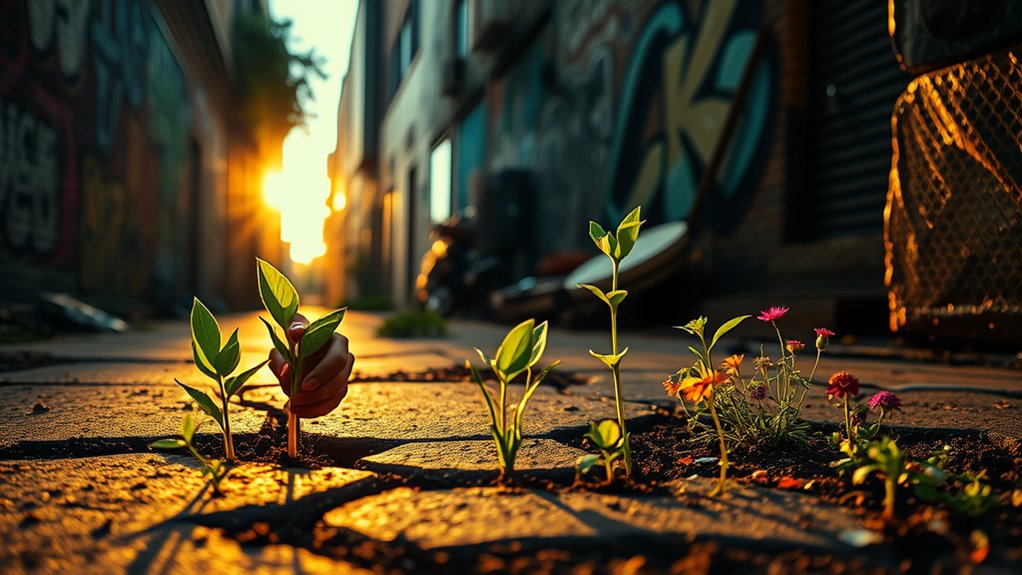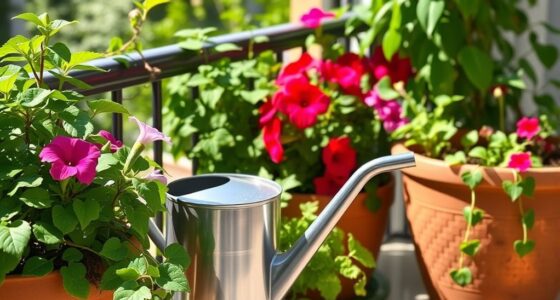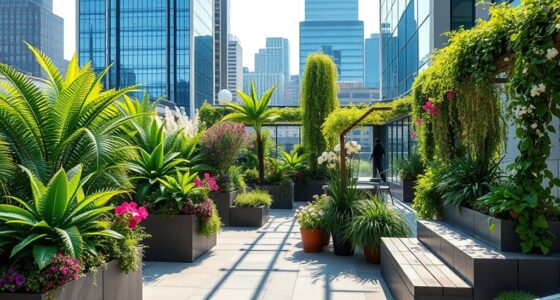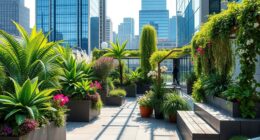Guerrilla gardening lets you secretly transform neglected urban spaces into lush greenery. Start by evaluating poor soils—add compost or use raised beds, or grow in containers to bypass soil issues. Choose hardy, native plants that thrive with minimal care and can handle pollution or foot traffic. Plant during low-visibility times, like night or early morning, and aim for seamless, natural results. Want to uncover more stealthy tips? Keep exploring to make your urban oasis a reality.
Key Takeaways
- Assess urban soil quality; improve with compost, aeration, or use raised beds to create suitable planting conditions.
- Select hardy, native, drought-tolerant plants that thrive in poor soil and require minimal maintenance.
- Plant during optimal times like spring or early fall, preferably at night or low-visibility periods to remain discreet.
- Use container gardens or raised beds for better soil control and easier installation in challenging urban environments.
- Incorporate visually appealing, low-maintenance plants that blend seamlessly into surroundings, attracting pollinators and enhancing urban beauty.

Guerrilla gardening is a bold way to transform neglected urban spaces into vibrant green areas. When you decide to take matters into your own hands, understanding the importance of urban soil and plant selection becomes essential. Urban soil, often compacted, polluted, or lacking nutrients, can be challenging for plant growth. Before planting, you need to assess and improve the soil if possible. Sometimes, simply aerating the soil or adding compost can make a significant difference, providing a healthier environment for your plants to thrive. If the soil is too degraded, consider using container gardens or raised beds where you can control soil quality more effectively. This approach allows you to create lush green spots even in areas with poor soil conditions.
Plant selection is another critical aspect of guerrilla gardening. You want plants that are hardy, drought-tolerant, and adaptable to urban environments. Native species are often the best choice because they’re already suited to the local climate and soil conditions, making them more resilient and easier to maintain. Consider planting low-maintenance options like grasses, wildflowers, or ground covers that can withstand pollution, foot traffic, and limited care. These plants not only survive in challenging conditions but also attract beneficial insects and pollinators, enhancing the local ecosystem. When choosing plants, think about their growth habits and size, ensuring they won’t become invasive or obstruct walkways. Opt for species with vibrant colors and textures to create a visually appealing space that invites people to appreciate and enjoy the area.
Timing your planting is essential, too. Spring and early fall are generally ideal because the weather encourages root development without the stress of extreme heat or cold. Be discreet about your guerrilla gardening efforts; plant at night or during times when visibility is low to avoid confrontations. Use biodegradable tags or markers if you want to label your efforts quietly, or simply let your plants speak for themselves. Remember, the goal is to blend your garden seamlessly into the existing environment, making it look like it’s always been part of the space.
Frequently Asked Questions
Is Guerrilla Gardening Legal in Most Cities?
You might wonder if guerrilla gardening is legal in most cities. It often isn’t, since local laws usually restrict planting on public or private land without permission. While your actions could be appreciated by the community, you risk legal trouble if there’s no community approval. To stay safe, consider working with local groups or gaining permission, ensuring you’re respecting laws and fostering positive relationships.
What Are the Best Plants for Urban Guerrilla Gardening?
Imagine you’re a secret gardener, like Robin Hood with a green thumb. For urban guerrilla gardening, choose native species and low-maintenance plants. They thrive in city conditions, require little care, and blend seamlessly into local ecosystems. Think hardy grasses, wildflowers, or succulents. These plants not only beautify neglected spaces but also support local wildlife, making your covert efforts both impactful and sustainable.
How Do I Find Suitable Locations for Guerrilla Gardening?
To find suitable guerrilla gardening spots, start by exploring neglected urban spaces like vacant lots or abandoned parks. Conduct urban soil testing to guarantee the soil is safe for plants. Engage in community collaboration by talking to neighbors and local groups to identify overlooked areas and gain support. This approach helps you discover hidden opportunities, making your efforts more effective and sustainable while blending seamlessly into the community.
What Tools and Supplies Are Essential for Guerrilla Gardening?
When choosing tools and supplies for guerrilla gardening, focus on essentials like sturdy gloves, a trowel, and a watering can. You’ll want to select plants suited to your environment, considering sunlight and soil. Keep your tools in good condition through regular tool maintenance to guarantee they last. Having the right plant selection and well-maintained tools makes your efforts more successful and discreet, helping you create vibrant green spaces effectively.
How Can I Prevent My Guerrilla Garden From Being Removed?
To prevent your guerrilla garden from being removed, you should focus on community engagement by involving local residents and neighbors. Building positive relationships can foster support and discourage removal. Additionally, consider the environmental impact of your actions, ensuring your garden benefits the area and aligns with local green initiatives. Respecting land use policies and choosing discreet locations also helps protect your efforts from unwanted attention or removal.
Conclusion
By secretly planting seeds in neglected cracks and abandoned lots, you become a city-saving superhero, transforming concrete jungles into lush, vibrant oases. Your guerrilla gardening efforts could turn gray streets into blooming paradise overnight, making the city feel like a secret garden just waiting to explode with color and life. With each daring act, you’re not just planting flowers—you’re igniting a green revolution that could overwhelm the urban landscape with unstoppable waves of nature’s beauty.









